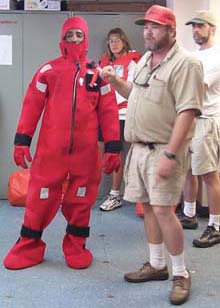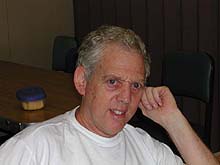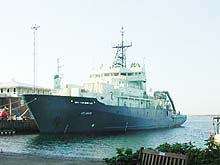Getting Your Sea Legs
September 9, 2001
Diana Payne
The Maritime Aquarium at Norwalk/
Connecticut Sea Grant
I'm on the sea! I'm on the sea!
I am where I would ever be,
With the blue above and the blue below,
And silence wheresoe'er I go.
-- Bryan W. Proctor, The Sea
It is a perfect late summer day in New England as all hands aboard the R/V Atlantis prepare for a 12 noon departure. The scientists have checked in with the chief scientist, located their berths, and stowed their gear. For those who have not yet experienced life at sea, the excitement continues to build as we explore the ship and prepare to leave the dock. After all the preparation for the Deep East Expedition, it is hard to believe that we are actually under way. As we watched the village of Woods Hole fade into the distance, we encountered the R/V Oceanus. It is rare for the WHOI vessels Atlantis, Oceanus and Knorr to be in or near port at the same time, so a media helicopter hovered over the water to record the event.

R/V Atlantis crew member Manny Lopes (right) discusses the immersion suit. Click image for larger view.
Life aboard a ship is quite different from living on solid ground. The first order of business is safety. The captain and crew advise science staff regarding procedures for "abandon ship," "man overboard" and "in the event of fire." R/V Atlantis crew member Manny Lopes demonstrated the "ease" of putting on a "Gumby" (immersion) suit. Adjusting to life at sea can be unsettling for those who have little experience on the water. Simple tasks, such as using the head (marnie toilet), manuevering a flight of stairs, or eating a meal can get a bit interesting in 5-ft swells. Living quarters are small but comfortable, and privacy is minimal. Although the nature of each cruise is serious, a good sense of humor is required, and there is always a little time for some fun!
Evening activities include a science staff meeting, where the scientists, educators, artists, writers, video specialists, and graduate students have their first opportunity to meet. Dr. Barabara Hecker provides a slide show of her extensive work with deep-sea corals. The seas remain calm as everyone begins to call it a day. Hurricane Erin's presence has not yet been felt, but the latest weather update still puts her likely path on a direct intersection with our planned course.
Interview with Dudley Foster
Expedition Leader/Senior Alvin Pilot
Woods Hole Oceanographic Institution

Dudley Foster, WHOI expedition leader and senior pilot of the Alvin submersible.
Ocean Explorer: How did you get involved with ocean engineering and working at WHOI?
Dudley Foster: My training is in mechanical engineering. I came to Woods Hole more than 20 yrs ago looking for a job. I applied for any job -- janitor, whatever! I was lucky enough to get a job as an engineering liaison. In those days, we were working on getting Alvin to the point where it was reliable enough for scientists to obtain good data. I was here with some of the early scientists who used Alvin.
Ocean Explorer: Do you spend most of your time working aboard ships like the R/V Atlantis?
Dudley Foster: At this point, I spend less time out at sea. We encourage all of our engineers to get out on oceanographic cruises once in a while, however. We do this because it's easy to forget the challenges that science teams and technicians face when they are out on the open ocean, deploying the ROVs (remotely operated vehicles) and DSVs (deep submersible vehicles) that we have developed. By the time that these vehicles and data-collection devices are deployed for use by scientists and technicians, they are well tested, and come with a "user manual" to guide the users in maintaining their safety and accuracy.
Ocean Explorer: What was the most important thing that you learned in school that directly applies to your everyday work with Alvin?
Dudley Foster: It's amazing how much you can get done when you understand the fundamentals of physics. If you use your brain and think about the fundamentals of physics, then it is much easier to figure out what needs to be done. Often, people trying to solve engineering problems make finding the solution too complicated. If they just remember the basics, they can usually figure out simple solutions to difficult problems.
Ocean Explorer: How do you control neutral buoyancy on Alvin?
Dudley Foster: We use a stem with a hole in the middle that goes into a cylinder -- only a certain amount of water can enter the cylinder. If you think about fluid flow, and the fundamentals of pressure and flow through a pipe, then you can visualize how we maintain neutral buoyancy for Alvin. We use the change in pressure, which is impacted by the length of the tube to create the variable ballast system.
Interview by Caren A.D. Menard of the Ocean Explorer Team.
Sign up for the Ocean Explorer E-mail Update List.

































